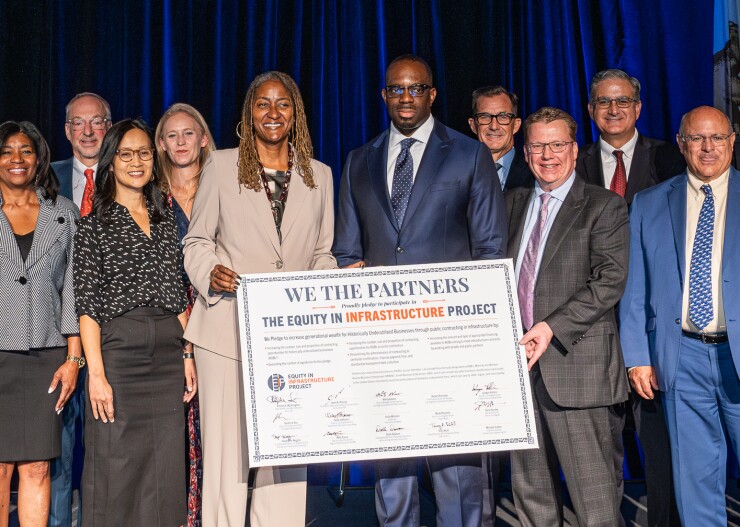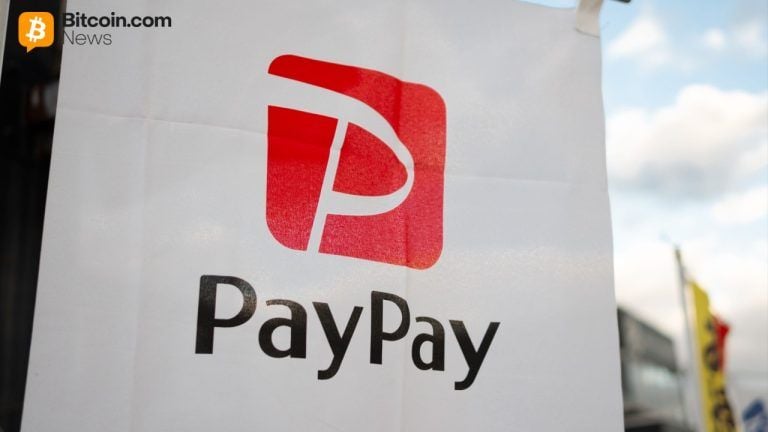Equity in Infrastructure Project gets pledges from 56 public agencies, private builders
6 min read

Less than two years after its inception in April 2022, the national Equity in Infrastructure Project reached 56 signers during a conference held in downtown Los Angeles last week.
The project asks for pledges to double the number of contracting opportunities for historically underserved businesses on infrastructure projects that use federal funds. Public agencies and private infrastructure and engineering firms that regularly work on government projects have been asked to sign.
“Creating opportunities for upward economic mobility is not a zero-sum effort,” said California Transportation Secretary Toks Omishakin. “In California we also know communities that have been underserved or overlooked require and deserve immediate and ongoing inclusion.”
Bloomberg News
Fourteen public and private sector infrastructure executives signed the pledge Nov. 20 at
“We are thrilled to have nine new partners in California who have signed on to this pledge,” said Omishakin, referring to the government agencies that signed on. “With an influx of federal and state funding, we have an opportunity to redefine the narrative for transportation infrastructure investments across California and the country.”
ENR’s forum provided an update on infrastructure programs and capital plans from leaders of the city’s key agencies like the Los Angeles County Department of Public Works, the Los Angeles County Metropolitan Authority and Los Angeles Department of Water and Power. All three were also pledge signers.
“We are really excited about the momentum,” said EIP co-chair John Porcari, a former U.S. deputy transportation secretary. “I have to admit it has been gratifying and somewhat surprising to see so much interest across the nation. It tells us there is real interest in both public agencies and private companies to do more.”
It’s also a recognition that executive level leadership is the most important single element, Porcari said.
“We have a commitment from both public and private companies to open up an aperture for underutilized businesses,” Porcari said.
The state of California has introduced a myriad of programs in recent years — not just in infrastructure, but also in public finance — that bring women-owned and minority-owned businesses to the table.
Porcari ticked off several other methods being brought to bear through the EIP project that, he said, take these efforts to the next level.
One — employed by California Treasurer Fiona Ma to
“It’s a win-win,” Porcari said. “It not only helps smaller contractors to increase their business, but it makes for more of a competitive bidding situation, which reduces the price for the government, if more people bid on a project.”
With the rollout of the funding through the $1.2 trillion Infrastructure Investment and Jobs Act
In addition to making projects more equitable — and spreading the business beyond a few big firms — because EIP’s strategies open up work to more firms, it will also mean that projects won’t face some of the delays government projects have experienced, Porcari said.
The California Plan led by Omishakin brings the signatory agencies together to work on a series of practical steps, like reciprocity in certification, and unbundling of project contracts to open it up for smaller contractors, Porcari said.

Jon Endow
It aims to achieve cross-agency information exchange on nuts-and-bolts best practices in the procurement process that “helps everybody create the kind of competitive bidding that results in better pricing and creates more opportunities for smaller firms,” Porcari said.
It will result in not just delivering infrastructure projects at better prices and more quickly, but mean building real community projects with the resultant economic multiplier effect, he said.
“Every objective observer agrees that we are way behind in infrastructure in this country,” Porcari said. “The American Society of Civil Engineers says we are way behind. EIP introduces new players and new capacity to the infrastructure world. Everything else being equal means better pricing and faster capacity and better benefits overall.”
The challenge is not just throwing percentages out there or getting more people; it’s important to get more small firms certified as minority-owned businesses, said Randall Winston, Los Angeles deputy mayor for infrastructure. “We need to do the education, outreach and hold their hands through the process until they are able to become certified as minority-owned businesses.”
Mayor Karen Bass committed in her budget to $50 million annually to repair sidewalks, which represents a pretty huge opportunity for small and underrepresented businesses to bid on projects that have ongoing funding, Winston said.
On example of putting the ideals of EIP to work is by “asking our Board of Public Works bureau to break up what has been large contracts” that have historically gone to the same massive firms, Winston said.
For instance, where a $15 million or $20 million contract may have gone to a large corporation that could easily handle a project of that scale, instead the work is broken down into smaller contracts to make it more competitive for small or medium-size businesses to compete with a smaller, dollar amount. Those unbundling efforts would be coupled with education or outreach to small or historically under-represented businesses.
“This model could be applied to any construction project,” Winston said. “But larger projects are ones we want to break up and make eligible for smaller contractors.”
Though Bass hasn’t decided on a goal number, Winston said that even doubling the number might not be ambitious enough for the mayor.
“We right now are developing these targets,” Winston said. “While the pledge is important and ambitious. It doesn’t put a hard number on doubling. We would like the target to be 20 to 25% of your 100% contracting. That should be the target. But we are still working out what would be a realistic goal.”
The collaboration that is part of the pledge is also in the mayor’s DNA, who is fond of using the term “locking arms” to mean that all of the city’s departments should be working together on such mutual goals.
And Winston said that is the case with EIP.
“We see a pathway [in these efforts] not just in public works, but in other offices in concert with each other, including work done by Rachel Freeman, the Deputy Mayor for Business and Economic Development,” he said.
EIP Launch
EIP was launched by co-chairs Porcari and Denver International Airport CEO Phillip Washington to ensure that equity was at the forefront as state and local governments moved ahead on projects spurred by Biden’s infrastructure bill.
Porcari was a Biden administration envoy
In those roles, the pair helped draft Biden’s Justice40 executive order as well as key transportation and infrastructure policies.
Porcari and Washington decided to take efforts a step further by creating EIP in which public agencies are asked to sign a pledge to significantly increase —
Pledgers in California include Los Angeles County Supervisor Holly Mitchell and Stephanie Wiggins, CEO of the Los Angeles County Metropolitan Authority.
The growing number of pledges in less than two years indicates to Porcari that gaining buy-in from “executive level leadership is the most important single element here.”
As for the private companies that signed the pledge, “they are making a commitment to reform their organizations, and consciously through joint ventures, are bringing in smaller contractors as prime contractors to create opportunities for historically underutilized businesses to bid as prime contractors,” Porcari said. “It’s a very specific commitment.”
The pledge has baked in accountability in which signers agree to meet certain metrics and there are plans to build an online dashboard on the
“There are a number of practical nuts and bolts techniques that open up opportunities for underutilized businesses and greater competition for public agencies,” he said.





